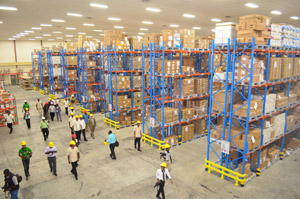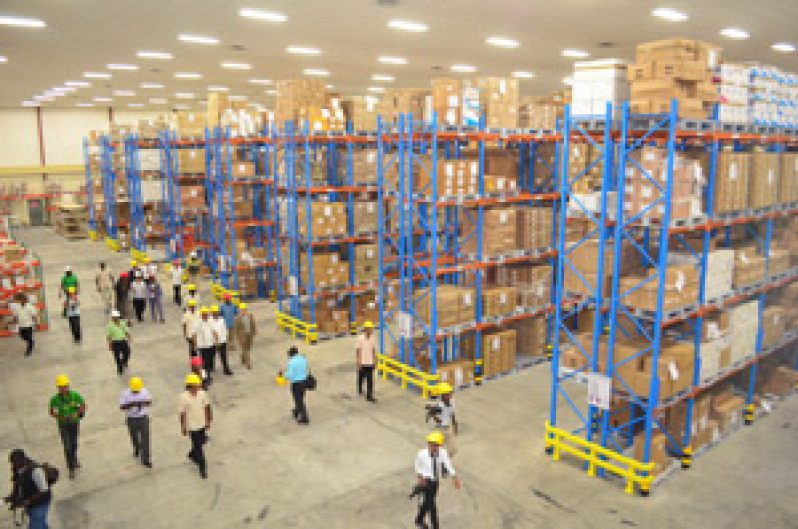THE Ministry of Health yesterday officially opened its 26,951 square meter Supply Chain Management Warehouse Complex at Diamond on the East Bank of Demerara, which boasts the first full radio Frequency warehouse management system in the Caribbean.
 The warehouse was financed jointly by the United States Agency for International Development (USAID), the Centre for Disease Control and Prevention, the Global Fund, World Bank and the Inter- American Development Bank, in partnership with the Ministry of Health through the President’s Emergency plan for AIDS relief (PEPFAR).
The warehouse was financed jointly by the United States Agency for International Development (USAID), the Centre for Disease Control and Prevention, the Global Fund, World Bank and the Inter- American Development Bank, in partnership with the Ministry of Health through the President’s Emergency plan for AIDS relief (PEPFAR).
Speaking at the opening ceremony, Acting President, Samuel Hinds said that the establishment of the facility is not only a great step forward in the provision of steadily improving health services in Guyana, but it is a great step in the overall development of Guyana and its people.
Hinds pointed out that since the People’s Progressive Party took office in 1992, development has been moving to higher and higher levels, making particular reference to the area of health services.
He remarked that the administration has been extending services throughout Guyana, which includes the restoration of health huts and the regional hospitals , as well as continually upgrading the physical facility at the Georgetown Public Hospital Corporation.
, as well as continually upgrading the physical facility at the Georgetown Public Hospital Corporation.
“With the assistance of the government and the people of Cuba, we’ve had a number of institutions put in place; I think seven diagnostic centres around our country. Additionally, we have made arrangements and so we’re beginning to see the flow to our country of some 700 persons trained in medicine and health services,” he added.
Hinds stated that as we journey to become a developed society, the tasks become more sophisticated than before and we have a challenge to rise to those higher levels.
He acknowledged the hard work of the partners in the project, and extended his gratitude to them for working with the Government of Guyana in many ways.
Minister of Health, Dr. Bheri Ramsaran, in his address at the opening ceremony, remarked that the facility is “too big to fail”, and functioning correctly, will be transformational.
Dr. Ramsaran pointed out that they came from the ‘drug bond’ at Mud Flats, Kingston, where they resided for many decades, noting that even before this project was conceptualized, they realised as an administration that the bond could not suffice.
He indicated that there was a long gestation period for the establishment of the warehouse, which would not have been possible without the patience and support of the five partnering organisations, along with the work of the Ministry of Health and the consultancy of the Supply Chain Management Systems (SCMS).
Dr. Ramsaran remarked that while the hard work of these agencies should be acknowledged, they need to recognise that they cannot become complacent.
He pointed out that management of the facility is critical, and in this regard, they need not only support from his ministry, but also support from the wider government.
According to him, the facility has the capacity to hold over 1,650 pallets (the base on which the drugs and medication are stored for easy movement), and has 40 staff members, predominantly women.
He added that these persons have been trained and are equipped with various skills.
Meanwhile, the United States Ambassador to Guyana, Mr. Brent Hardt, in his remarks, said that they are very pleased to see the culmination of this vital stepping stone on the road to ensuring that Guyana’s pharmaceutical management operations are world class.
“This impressive new warehouse is a product of the decade-long partnership that the United States and Guyana have forged under the President’s Emergency plan for AIDS relief (PEPFAR), and stands as a physical ‘bricks and mortar’ achievement that serves to remind us not only of what we have accomplished together, but also what remains to be done,” he stated.
He further stated that the legacy of PEPFAR is not in the structure of a building, but in the lives saved and the life-saving capacity that has been developed through it.
Mr.Hardt extended his gratitude to all of the partners on the project, particularly the SCMS project staff for their professional co-ordination efforts and sound technical assistance.
Construction of the warehouse began in 2009, and the facility consists of modern racks and refrigeration applications which cater for drugs and medication such as vaccines and insulin.
The financing agencies gave a total of approximately $375M, coupled with the Government of Guyana’s contribution of $120M, and these also included funds from the Supply Chain Management Systems (SCMS).
This agency is based in South Africa, and is among the best in warehouse management of medical supplies.
SCMS is funded by the President’s Emergency plan for AIDS relief (PEPFAR), through USAID, and is implemented by the Partnership of Supply Chain Management (PFSCM).



.jpg)








